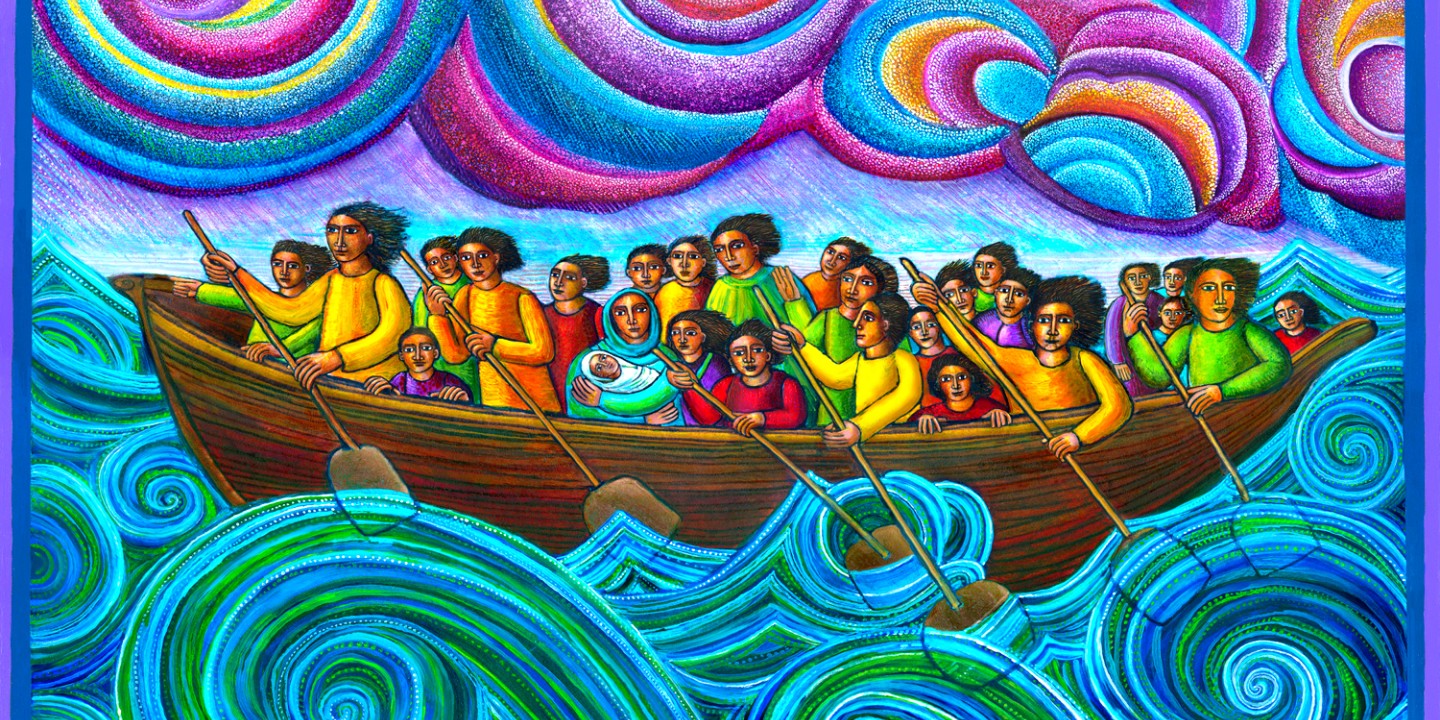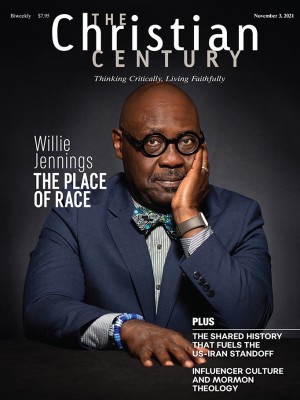The holy simplicity of artist John August Swanson
His art is like the man who created it: joyful, loving, and gently curious.

At first glance, the art of John August Swanson seems simple and bright, a cheerful and untroubled expression of joy and hope in God and the world around us. It would be easy to stop there, as I did through many years of seeing his work on the covers of church bulletins, on religious greeting cards, and occasionally on a colleague’s office wall. The sunny and humane images didn’t seem to me to require much thought, and for a long time I appreciated them for their cheerfulness alone. I also assumed the artist was a Lutheran, given the name Swanson and the fact that I saw his work most often in Lutheran settings.
But then life took me into his orbit. I left the Northeast and took a teaching position in Southern California, at California Lutheran University. There, too, I found a bright array of his serigraph prints and their reproductions adorning the walls. It seemed like everyone I knew had one in their office or home, the latter often in the dining room, as if to invite fellowship and conviviality with the cheerfulness of the colors. It was in Los Angeles that I learned that Swanson’s story was far more complex than I had known—and that he was the child of immigrants from Sweden and Mexico, a devout Catholic, and a truly wonderful person. I came to know people whose lives he’d touched. And finally, I met the man himself.
Read our latest issue or browse back issues.
It was not a planned or even a very dramatic meeting. I was attending worship at the church of a Lutheran pastor friend, and during the service a slight, elderly man named John stood up and played a simple but truly lovely violin solo. I sat down next to him at the coffee hour afterward and asked him if he was a professional musician. He just said, “No, I mostly make art,” and introduced himself as John. At that moment my pastor friend joined us and told me that this was John August Swanson, the artist. I was a bit starstruck. John was self-effacing and didn’t want compliments. It was a short conversation, but before I left, John took my hand and told me he was glad to have me as a friend.
Somehow that encounter opened John’s art up to me in a new way. Until then I had enjoyed it but not paid it much attention—it was brighter and more cheerful than my usual taste in art. What I hadn’t reckoned with was how much it was like the man who created it: a many-layered experience of profundity expressed in simplicity, of a nuanced joy expressed in a deeply humane way. I began to look at the images more closely. I asked friends and associates who had John’s art on their walls what drew them to the images. And I began a conversation with John and his art that continues to this day. Though he had many friends who knew him better and longer than I did, his friendship was very important to me, and it and his art strengthened me as they did so many others.
From the day I met him, I rejoiced at every opportunity I had to spend time with John. His lack of guile, his unforced charm, his openness to whomever he was with—to talk with John was to be embraced by a gently curious, deeply loving person. I’ve never known anyone like him, and it is no surprise to me that many who knew him thought of him as being close to a living saint. Though he was internationally renowned and his art hung in collections around the world, he was fully caught up in being present in the moment with anyone he encountered. It was fun to watch him take people by the arm and show them something he wanted them to see in his images. His joy in sharing his work was palpable. When I saw him at conferences, selling posters and prints and cards, I always had the sense that if he hadn’t had people there to help him, he might have just given it all away for free.
When I look at John’s art, it’s this openness to people that I now see most strongly. There are always people in it, and they are what is most compelling. They’re depicted simply but with great affection, a kind of invitation to put oneself into the image. I remember particularly one of his depictions of the Last Supper, which he kindly permitted me to have printed on a large vinyl banner for use as a backdrop at events, and which dominated one wall of my office’s conference room. I always tried to sit opposite it, and looking at it never got old. The disciples gathered around the round table in the picture were not strongly individualized—they were just human beings. That a few of them (but only a few) had beards suggested at least that some were male and some were female—but it was the gender fluidity of the images that really caught my attention. They were just people, gathered at a meal, with a man they truly loved. Jesus himself was not much different from the others, except for his central position and a halo, which also could have been the moon outside.
Holiness depicted in simplicity is characteristic of John’s art, and nowhere did life and art come closer together for him than in his depictions of Francis of Assisi. St. Francis was important to John, and we talked about how Francis lived in the world yet always seemed to have a foot outside of it, with Jesus. Much of my friendship with John came during the pontificate of Pope Francis, and John was overjoyed that this man who bore the name of his favorite saint should also himself be an inspiration. John listened closely to Pope Francis’s messages, and some of them ended up in his later works, especially in his last great image, called The Storm, which was inspired by the pope’s Urbi et Orbi address from 2020, delivered in solitude, in the rain, in St. Peter’s square. In this speech, the pope alluded to the global pandemic as a storm humankind needs to weather together, all of us in the same boat in the same storm.
In the summer of 2020, John took this image of a community in a boat together and created a gorgeous painting with swirls of color for sea and winds and sky and a group of passengers huddled together and trying to row. The painting is dramatic and dynamic but also hopeful. The passengers (as in many of John’s works) are not sharply individualized—they represent us, too, and our struggles to keep trusting God and hoping in the future. A large print of this painting hangs on my office wall today, a gift from John and other friends as I left California and moved back East to a new call. It was a parting gift in more ways than I can say, since I never got to see John in life again. But every glimpse of the vibrant colors speaks to me of his quiet but vibrant life—and the love of God he represented to me and all who love his work.





